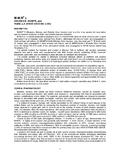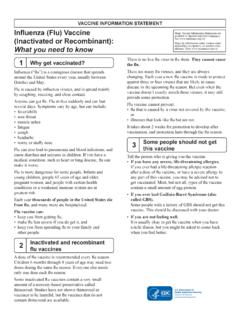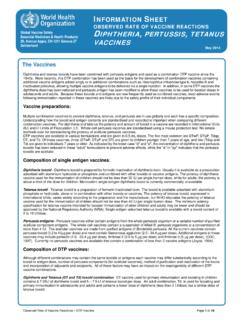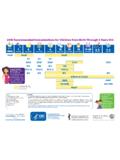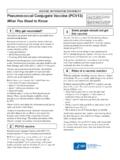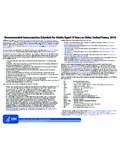Transcription of OBSERVED RATE OF VACCINE REACTIONS …
1 OBSERVED Rate of VACCINE REACTIONS MMR Vaccines Page 1 of 11 Global VACCINE Safety Essential Medicines & Health Products 20, Avenue Appia, CH-1211 Geneva 27 Switzerland s & Health Product 20, avenue Appia, Ch-1211 Geneva 27 The Vaccines Monovalent vaccines: Numerous live attenuated measles vaccines, most derived from the Edmonston strain, are currently produced worldwide. Other vaccines containing non-Edmonston derived strains are also in use including Leningrad-16, Shanghai-191, CAM-70 and TD97. Most measles vaccines are produced in chick embryo cells, but few vaccines are grown in human diploid cells.
2 Most vaccines do contain small doses of antibiotics ( , 25 g of neomycin per dose), but some do not. Sorbitol and gelatin are used as stabilizers but not all vaccines contain gelatin in the final product (Redd et al., 1999). More than ten live attenuated mumps VACCINE strains (Jeryl Lynn, Urabe, Hoshino, Leningrad-3, L-Zagreb, Miyahara, Torii, NK M-46, S-12 and RIT 4385) have been used throughout the world. The Jeryl Lynn strain is used in many countries. Most vaccines contain 25 g of neomycin per dose. Several manufacturers in Japan and Europe produce a mumps VACCINE containing the Urabe Am9 virus strain. However, concerns about VACCINE -associated meningitis prompted several countries to stop using Urabe VACCINE strain (WER 1992).
3 Other vaccines have more limited distribution. In most cases, the viruses are cultured in chick embryo fibroblasts (such as for the Jeryl Lynn and Urabe strain-containing vaccines); however, quail and human embryo fibroblasts are also used for some vaccines. Most live attenuated rubella vaccines used throughout the world contain the RA 27/3 virus strain (Plotkin, 1965). Exceptions are vaccines produced in China (BRD2 virus strain) and Japan (Matsuba, Takahashi, and TO- 336), produced on rabbit kidney cells, and the Matsuura strain, produced on quail embryo fibroblasts. The RA 27/3 strain is used most often because of consistent immunogenicity, induction of resistance to reinfection, and low rate of side-effects (Plotkin et al.)
4 , 1973). The live-attenuated virus produces viraemia and pharyngeal excretion, but both are of low magnitude and are non-communicable (Plotkin & Orenstein, 1999). Combination vaccines: The most frequently used combination is the Measles, Mumps and Rubella VACCINE (MMR); the MR VACCINE is also used in few countries as well. More recently the MMR VACCINE has been combined with the Varicella VACCINE (MMRV). Types of vaccines Route VACCINE antigens Excipients Monovalent Measles VACCINE strains include; Edmonston strain and Non-Edmonston derived strains include Leningrad-16, Shanghai-191, CAM-70 and TD97 Antibiotics ( 25 g of neomycin), Sorbitol and gelatin Mumps VACCINE strains include - Jeryl Lynn, Urabe, Hoshino, Leningrad-3, L-Zagreb, Miyahara, Torii, NK M-46, S-12 and RIT 4385.
5 Neomycin 25 g of per dose. Rubella Most vaccines contain the RA 27/3 virus strain Japanese derived strains include - Matsuba, Takahashi, and TO- 336 China - BRD2 Combination MMR Various combinations of above strains in different vaccines MR The VACCINE is prepared from the live, attenuated strains of measles virus and RA 27/3 rubella virus. MMRV Various combinations of above strains in different vaccines and the Oka strain of the Varicella Zoster virus INFORMATION SHEET OBSERVED RATE OF VACCINE REACTIONS MEASLES, MUMPS AND RUBELLA VACCINES May 2014 April 2014 OBSERVED Rate of VACCINE REACTIONS MMR Vaccines Page 2 of 11 Adverse events Measles vaccines Mild adverse events Local REACTIONS are not uncommon following administration of vaccines containing measles antigens.
6 Within 24 hours of vaccination, recipients may experience pain and tenderness at the injection site which is generally mild, transient and resolves within 2-3 days. Systemic REACTIONS includes fever >103 C occurs in about 5 to 15% of VACCINE recipients between the 7th to 12th day after vaccination and lasts approximately 1 to 2 days. In some cases, the fever may be coincidental, due to other infections. Measles vaccination also causes a rash to occur in approximately 2% - 5% of vaccines. The rash typically occurs 7 10 days after vaccination and lasts about 2 days. Mild adverse events occur less frequently after the second dose of a measles-containing VACCINE (Chen et al., 1991) and tend to occur only in those not protected by the first dose (Davis et al.)
7 , 1997). For persons receiving a second dose of measles VACCINE , it is likely that the vast majority (approximately 90%) will already be fully protected by the first dose, leading to immediate and complete neutralization of the VACCINE virus. Therefore, it is reasonable to assume that the risk of events will be decreased by a corresponding factor with the exception of allergic REACTIONS . Likewise, there is no reason to believe that persons receiving more than 2 doses would be at higher risk for adverse REACTIONS . Severe adverse events Allergic REACTIONS , including anaphylaxis: Hypersensitivity REACTIONS , including urticaria at the injection site, rarely occur following use of MMR, MR or its component vaccines. Anaphylactic REACTIONS are thought to be extremely rare.
8 The rate of anaphylaxis has been documented to be variable with a rate of to 10 per million doses of following a measles-containing VACCINE (Bohkle K et al 2003). This variability is accounted for the different case definitions used for anaphylaxis and the variable methods used for case ascertainment such as passive or active surveillance. Recent studies indicate that anaphylactic REACTIONS to measles VACCINE are not caused by residual egg proteins but by other VACCINE components. Case reports have shown that about one-half of individuals experiencing anaphylactic REACTIONS following MMR vaccination had IgE antibodies to gelatin, a stabilizer used in VACCINE production (Kelso et al., 1993; Sakaguchi et al., 1995). The risk for serious adverse REACTIONS in those individuals allergic to eggs is low.
9 The prick and intradermal testing with measles-containing vaccines do not predict reaction to these vaccines which have been given safely to people with serious egg allergy (Fasano et al., 1992; Kemp et al., 1990; James et al., 1995). A history of egg allergies is therefore no longer considered a contraindication to immunization with a measles-containing vaccines. Seizures: Measles-containing VACCINE can cause febrile seizures. By linking vaccination records with computerized hospital admission records in five districts in the UK, Farrington et al. (1995) found that 67% of admissions for a febrile convulsion 6 11 days after MMR vaccination were attributable to the measles component of the VACCINE (risk 1 in 3,000 doses). Other studies have found a seizure rate of 1 per 2,941 and 1 per 1,150 doses (Barlow WE et al 2001, Miller E et al 2007).
10 An association between MMR VACCINE and residual seizure disorders has not been established (Stratton et al., 1994). Children with a personal or family history of seizures are at greater risk for idiopathic epilepsy, however, febrile seizures after vaccination do not increase the likelihood that epilepsy or other neurological disorders will develop in these children. Children with a history of convulsions may be at increased risk for febrile convulsions after MMR vaccination, but the risk appears to be minimal (CDC, 1989). In pre-licensure studies for MMRV vaccines, fevers were transient and there was no difference in the incidence of febrile seizures. However in post licensure studies, there were significant differences. This is outlined in the MMRV VACCINE section.










